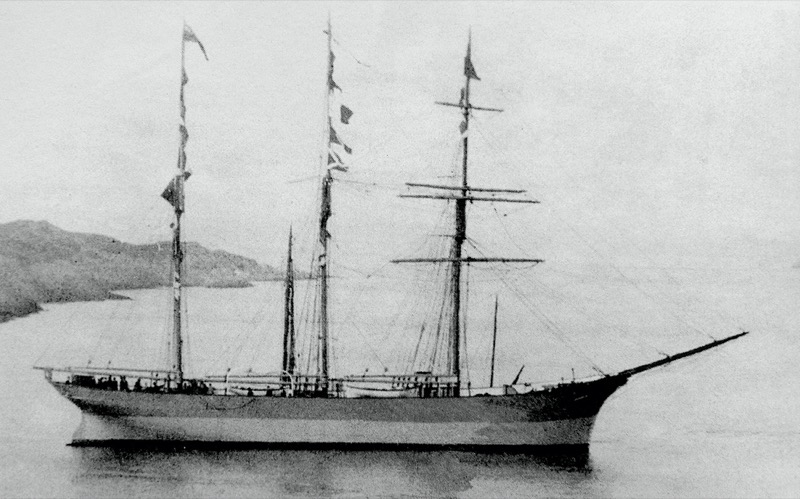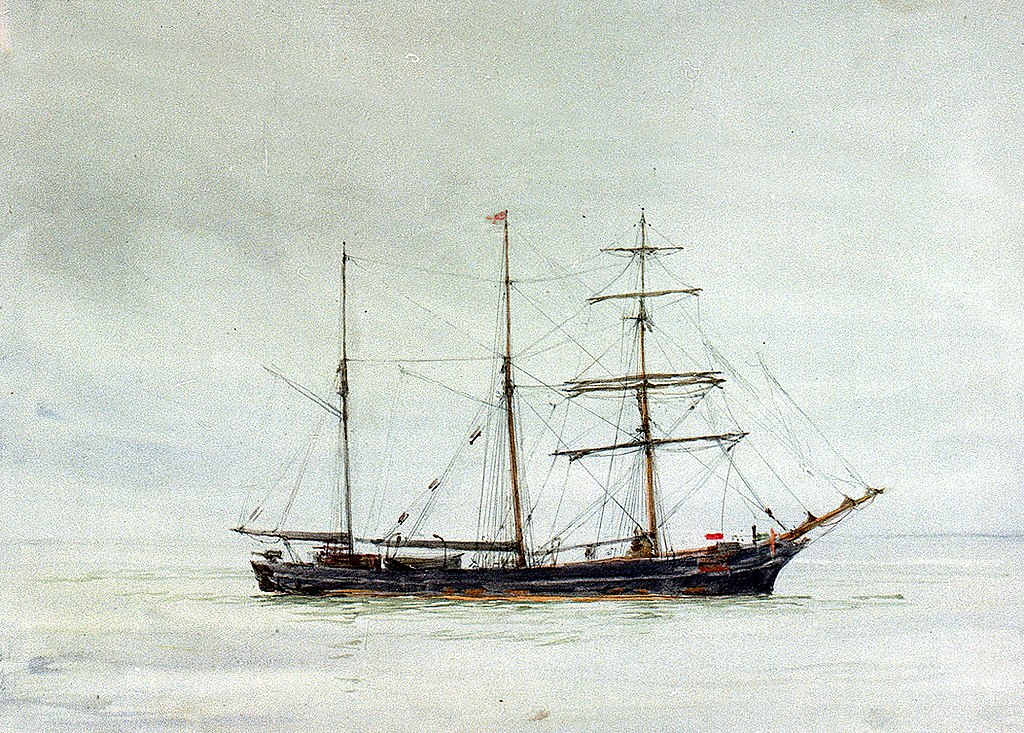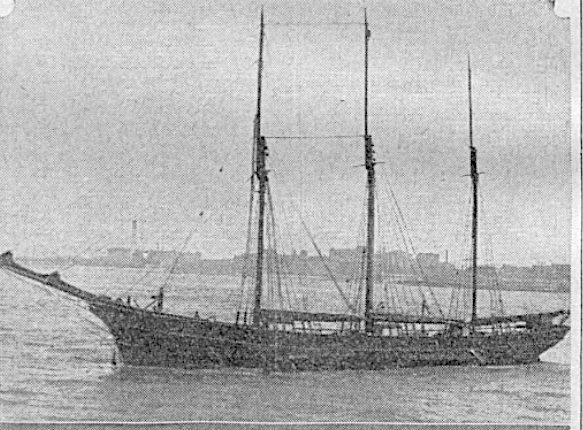
Iron barquentine Gaelic, built William Thomas, Amlwch, 1898.
224grt, 174nrt, 127x24x11ft, ON 101760.
First owners: William Thomas of Amlwch, registered Beaumaris.
• Collision on 21 August 1909 in Mersey with SS Rostrevor,
cargo bone ash from Rio Grande to Ellesmere Port, beached at Egremont, crew saved, repaired.
• During World War I, 1916-9, employed as a Q ship [HMS Gaelic]
Two crew reported lost from gunfire from UC47 on 22 April 1917, SE of Fastnet.
Around 1923, bought by O'Toole family of Ballinacurra, Cork.
Oil engine (100 hp, later 150 hp) added around 1921.
Registered Dublin from 1932.
• Collision in Mersey with MDHB dredger, Burbo, on 17 February 1939,
cargo clay from Dublin to Weston Point; sunk near Brunswick Dock, 5 crew saved.
Wreck lifted and taken to Tranmere beach (for breaking up?)
Launch of Gaelic at Amlwch 1898.

First sinking 1909
Liverpool Daily Post - Monday 23 August 1909
COLLISION IN THE MERSEY. WELSH SCHOONER BEACHED AT EGREMONT.
On Saturday morning, during a slight gale, a collision took place
in the Mersey between the schooner Gaelic, of Beaumaris, inward bound
from Rio Grande [Brazil] to Ellesmere Port, and the steamer
Rostrevor [of Newry]. As a result of the impact, Gaelic, which was
laden with bone ash, was beached at Egremont, where she is now lying
on her side. The Gaelic is a schooner of 224 tons, and belongs to W.
Thomas and Sons, Beaumaris.
A later report of the Liverpool
Underwriters Association: The steamer reported in collision with the
Gaelic, was the Rostrevor, outward bound from Garston. When the
collision occurred two of the crew of the Gaelic jumped into the
steamer. The remainder the crew left their vessel and got on board the
[tug] Andrew Joliffe, which had gone their assistance. They returned
again for the purpose of making a hawser fast to the Andrew Jolliffe,
which towed the schooner, as stated, to the Egremont beach.
In a subsequent court case, the Rostrevor was held responsible for the collision.
Liverpool Journal of Commerce - Thursday 02 September 1909
THE SALVAGE OF THE GAELIC. - To be Refloated This Morning.
It is expected that during this morning's tide the barquentine
Gaelic, which has been lying on the beach to the north of Egremont
pier for several days, will be refloated, and towed to her
destination. On Monday, the salvors succeeded in righting the vessel,
and, in the meantime, the ship-repairers have been busy patching up
the large rent made in the side through the collision. When these
repairs are completed, all the water will be pumped out of her, and
she will be floated on the rising tide this morning.
Liverpool Daily Post - Friday 03 September 1909
ON EGREMONT SHORE. The three-masted schooner Gaelic, which has been on
the sands at Egremont after colliding with a steamer, was refloated yesterday,
and towed up the Mersey to Runcorn, where she will undergo repairs.
At the time of this sinking, Gaelic was crewed by many Welshmen - her Captain was Ishmael Williams from Anglesey - but also had a German, a Finn and a 14 year old boy, Ernest Ellis, from Egremont, on his first voyage.
War time activity 1917
During part of World War I, Gaelic was employed as a Q-ship [the name Q comes from the
initial location of Queenstown (now Cobh) as a base for these vessels]. Requisitioned
from November 1916 to March 1919 and operated as Brig 11, Gaelic, Gobo and Q22.
She was armed with two 12-pounders, disguised as deck-houses.
On 22 April 1917, under the command of Lieutenant G. Irvine,
R.N.R. (who received a DSO for this action), after a lengthy fight, she saw off submarine UC 47 (Paul
Hundius). She was herself damaged by gun-fire, with 2 crew lost and 4
injured. She managed to avoid a torpedo fired at her also. Location:
off Mine Head, also given as 48 miles S of Kinsale Head. The report of this
encounter mentions her starboard and port engines, since it was calm
weather, so she must have already been fitted with auxiliary motors by
1917.
Gaelic is also reported as having indecisive duels with
submarines on June 26 and on July 2 1917, in the English Channel.
[source]
A report from 1939 (see below) states that Capt O'Toole was
mentioned in despatches when Gaelic served as a Q ship during the war.
Drawing of vessel (presumed to be Gaelic) as a Q-ship, circa 1916
[from National Maritime Museum, Greenwich]:

Second sinking 1939
Photo of her from Liverpool Echo, 1939, as an auxiliary motor schooner:

Liverpool Echo - Friday 17 February 1939:
The 3 master schooner Gaelic (224 tons) sank after a collision with the
Dock Board's dredger Burbo off Brunswick Dock at 8 o'clock this morning,
the crew escaping in a small boat.
The collision was seen by a large crowd of people on Brunswick Dock,
most of whom were attending to vessels proceeding in and out
of dock. The Gaelic, possessing an auxiliary engine, was proceeding
up-river to Garston, and the Burbo was dredging near Brunswick Dock
entrance.
WATER POURING IN. An eye-witness on Brunswick Dock said: I
was surprised to see the schooner sink, so quickly did the incident
happen. Many people had been watching her proceed up the river. We
watched her pass close to the wall but never expected there was any
danger of collision with the Burbo.
Suddenly I saw the two boats close
together. There was a lot of shouting and it seemed that danger to the
schooner was far greater than appeared from the dock wall. It was
obvious that water was pouring into her. I saw the Burbo maintain
touch with the schooner, trying to cover up the damaged part and then
I saw a small boat going on the scene. I expected to see the schooner
disappear completely from view, but the top of her three masts
remained visible.
Admiration then crash.
Another eye-witness told the Echo: I was
standing on the quay admiring the speed of the schooner, which was
going up stream with the wind and tide behind her. She had no sails
set, but was under motor. At the same time the Burbo was cautiously
nosing her way out of Brunswick Dock into the river. Whether the tide
caught the schooner, or whether she saw the dredger coming and tried
to go about, I don't know, but there was a collision. I could hear the
crash from where I stood. The schooner seemed to swing round against
the side of the dredger and sank almost immediately. The master and crew of four
were brought ashore to Liverpool and later taken to the Sailor's Home, Canning
Place. They will stay here for about two days, and will be given fresh
clothing and tickets to their homes in various parts of Ireland by the
Shipwrecked Society.
HAD WE WAITED: The names of the captain and crew are: Captain
William O'Toole, of Cork (husband of the owner); William Wolohan, of
Cork (mate); Arthur Tyrell [Tyrrell in another report] and James
McCarthy (ABs); and Patrick Ivory (ordinary seaman). Tyrell belongs
to Cork, and McCarthy and Ivory to Arklow. The captain, in an
interview, told the Echo: - We launched our own boat and got off just
before the ship sank. Had we waited for a boat from the dredger we
should have been in the water.
The Dock Board salvage
steamer Salvor was quickly on the scene, and the work of raising the
schooner, which in its present position is a danger to navigation, was
taken in hand.
Liverpool Journal of Commerce - Saturday 04 March 1939:
The wreck of O'Toole's auxiliary barquentine Gaelic was raised from
the Mersey and put on to Tranmere Beach.